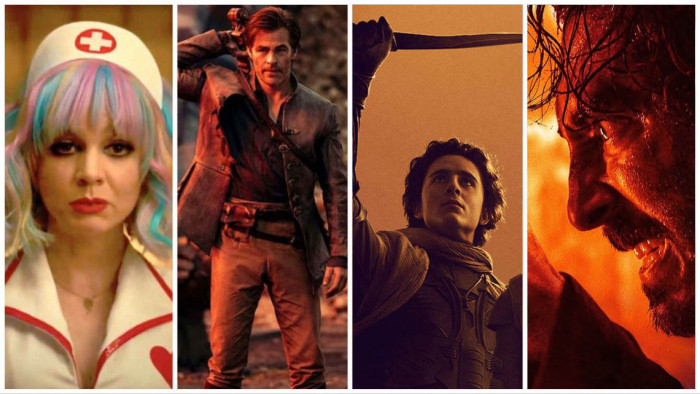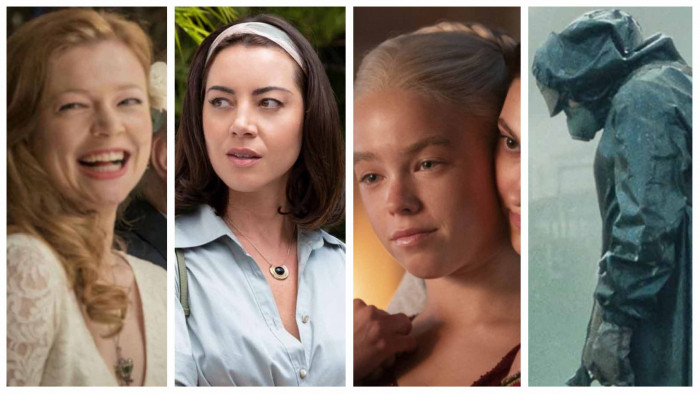Think back to ten years ago - what were you doing? Obviously, you were watching television, but exactly how were you watching it? You were most likely consuming it live, on terrestrial, freeview, or Sky. Maybe you had the odd show recorded and watched at a later date, but the TV guide was still a big part of your televisual routine. Think back another ten years, and it was everything.
But now, in 2017 - which is the future, isn’t it - it’s all changed. I even know a few deviants that don’t even have a TV licence - they simply use Netflix, and that’s it. Or Amazon Prime, or Apple TV, or one of those other weird ones that nobody else has. TV is not TV anymore, it is a library, a giant museum of content, every artifact available immediately - and you are actively encouraged to touch the exhibits. Nobody rushes home to watch something anymore, because you can simply watch it an hour later, or even five minutes later - time no longer has any meaning. We live in Star Wars, or something.
But what on God’s Green Ethernet Cable will television be like in another ten years’ time? Will everything be streamed directly into our brains using a sharp blast of radiation, a flicker of light reflecting from within our glazed-over eyeballs the only hint that we are still alive and still consuming? Will we simply have no need for a remote; all that’s required is the slightest echo of a thought, and anything we desire to watch is immediately beamed into our skulls? There are so many questions.

Will Smith in new Netflix Original movie, Bright
So I went to Berlin, where Netflix held one of those ‘conference’ things you hear so much about (but have never been to), in an effort to discover the future of television, the future of entertainment, the future and/or end of the world.
Already, Netflix has conquered the globe, this is a given. They have more than 109 million members across 190 countries, and this is reflected in the six-billion-dollar-budget that will be spent on production and licensing next year. This is Hollywood-level shit, and only ten years ago they were still a DVD-rental business (whatever that is. DVD? No idea mate) - the growth has been truly astonishing.
On their impressive roster already, they have more 400 original series and movies, from 20 different countries, which is double what they had last year (they only started creating original content five years ago, sheesh) - Netflix is becoming its own film industry at an alarming, but also welcome, rate. But what will it look like in the future? What changes are already in the early stages of germination? What will Netflix look like in five, or ten years time?

Dark is one of Netflix’s latest original series
We might have to stop calling it ‘television’
Already, in 2017, Netflix is available on over 1,500 different types of device - a stark contrast to ten years ago, when the thought of watching a film on your phone was altogether quite ridiculous. Now, Netflix’s aim is to maximise the benefit on alllll devices - that includes electronics without screens, like Alexa, which now includes support. So now you can shout “Alexa, you robot bastard, let me watch American Ninja for the eighth time today” at it, and it’ll flip it straight up on your smart TV.
However, although it’s available on so many different types of device, Netflix is still most popular on the television - whether that’s through a smart TV, Playstation or Chromecast etc. - its preferred consumption is on the biggest screen in the house. But is it truly ‘television’ as we know it? I spoke to Greg Peters, Chief Product Officer at Netflix, to ask him if broadcast television will soon be a thing of the past.

Stranger Things 2 was a huge hit
He said:
“My wife is very excited about a show that is only available on broadcast and I’ve had the opportunity to go back and try to watch it, but it’s hard! It’s the waiting component, the video quality isn’t up to scratch, there’s ads to skip - it’s driving me insane. We were like ‘This is ridiculous, it’s not worth it’. Once you’ve tasted that experience, where you’re in control and it’s organised around your life, then it’s really hard to go back.
“However, I don’t think it’ll disappear completely, because it does certain jobs really well. You look at sports, the news, things that are available, live in the moment, and broadcast is good at that. So I just think it’ll migrate in terms of the jobs it does for us - we’ll see fewer scripted series and other things that benefit from this new form of distribution. It’s more like: what’s the right tool for the job that you have?”
As such, Netflix has no immediate plans to get involved in live TV or sports coverage, and will continue on evergreen viewing material that has a longer shelf life. Because imagine binge-watching 12 football games in a row - you might die.
But that won’t mean that it’s not going to change the actual notion of a television forever. Just as Sky TV did, and set-top boxes after that, Netflix will seamlessly integrate themselves into our idiot boxes through default options on menus and remotes - it’ll be easier than ever to immediately access your precious library of time-waste. You’ll even be able to resume exactly where you left off as soon as you flick on the TV, which will be a tad annoying if you want to watch Dinner Date, but still.

The Punisher is one of many Marvel shows Netflix has helped create
The picture and sound quality is going to blow our minds
Remember that oft-parodied advert for Maxell back in the ‘80s (no) that showed a bloke being literally blown away by the fantastic sound quality from his speakers? Well, on the strengths of the tech that Netflix are currently working with, that might soon be a reality.
Over in Berlin I was lucky enough to experience the wonders of Dolby Vision HDR (High Dynamic Range) and Dolby Atmos, a sound and picture standard that eclipses all that came before it. Add that to 4K support and you’ve got an immersive experience that’s the next best thing to sitting in a cinema. Perhaps even better because you don’t have to deal with any fucking laser pens.
Dolby Vision essentially ups the amount of colours that the screen can process, so pictures are more vivid and immersive, and Dolby Atmos uses a system that makes the audio sound like it’s surrounding you in 3D. That’s sound above you. It’s a peculiar, but a diaphragm-shaking delight. Don’t believe me? To prove how much better than previous formats they are, since the introduction of both standards, films utilising both technologies have won Oscars every year since.
Netflix already has the highest 4K offering on the planet, as well as more than 100 Dolby Vision titles and more than 230 Dolby Atmos ones, so just expect that library to widen.

Netflix is going to take over the entire world
Netflix only went fully international last year, with a now-reach of 190 countries, and although each country has its specifically-tailored selection of films and shows - there’s still a greatly inclusive overlap there. As more and more countries are added, more and more original programming from each of these countries will be rolled out worldwide.
Greg says:
“I’m personally super excited about the idea that we’re gonna break down the boundaries, markets and structure of how entertainment has been produced. With the exception of Hollywood and British productions, a lot of this stuff doesn’t travel very far, so I love the idea that we’re going to work with creators all over the world and find where those best stories are.
“What’s amazing is that you find that we’re producing this crazy show called Narcos in Colombia, mostly in Spanish, with a little bit of English, starring a Brazilian actor, and there’s an 80-year-old woman in the north of Japan watching this show. Where would that have happened before? That’s super cool.”
That’s cocaine from even more countries - what choice!

Narcos is heading into its fourth season
Things are going to get pretty personal
All you Netflix-heads will already be familiar with the way the user interface tailors suggestions to your tastes as it is, but this is going to become even more in-depth and intimate as the years roll on.
Netflix are constantly trialling new features and ways of making the whole experience even easier and more suited to individuals - hundreds of tests are normally running at any given time. For example, you may notice that on your homepage, featured shows play video trailers instead of static images now - this was the result of two separate groups of new members having access to one or the other for a trial period. Their activity and behaviour was closely monitored - those who stayed members for longer, watched more and used other key signals had their preferred interface made official overall.
The reason new users were used is because people hate change, don’t they. Don’t change the font on Twitter! My life is over! etc.

Orange is the New Black, one of Netflix’s first breakout original hits
Greg says:
“At the moment, Netflix is essentially a uniform engagement model. So this is what I think is a crazy idea: you have different moments in your entertainment journey, like you’ve seen this great new German drama called Dark. You’re on Episode 4 and you’ve been hitting one episode per night for four nights - our job is basically to get you to Episode 5 as fast as possible, because we’re pretty darn certain that that’s what you want.
“So what happens if you launch Netflix and we just start playing it? Or, when you’re done with Dark but you’re in that moment and need something else to explore? If you’ve watched Dark, we’re pretty sure that Stranger Things is a great option for you, so maybe rather than showing you 20 different things to watch, maybe we just show you a really strong trailer, or even just start playing Stranger Things and see what happens?
“It’s super interesting, but super hard and I want to experiment with it.”

BoJack Horseman being his usual sad self
Rules for TV shows? Throw them out the window, bozo!
When you think of a common-or-garden television programme, you think of something that comprises episodes of either 30 minutes or an hour - that’s the industry standard, isn’t it (plus ads). Netflix aims to eliminate the traditional constraints inherited in the industry, because they are not a historical form of distribution.
The programme creators of Netflix Original content have no set rules, so can do whatever they want. Look at The OA - some episodes were over an hour, others were 30 minutes - whatever story they wanted to tell, and in whatever way they wanted to tell it, was accessible for them in any form. Maybe in ten years’ time we’ll all be raving about the episode of Stranger Things 5 that was only 13 seconds long, who knows.

Daredevil broods in The Defenders
Things are getting interactive, baby!
Interactive shows are already available on Netflix, but titles like Puss in Book: Trapped in an Epic Tale are specifically for kids (which potentially includes you, if we’re being honest here). Essentially, what this format offers is is a chance for the viewer to decide which way the story goes, by choosing from two options at crucial parts of the story. It’s proved popular with the youngsters, who according to viewing figures, seem to prefer it over linear storytelling. But how would this work for adults?
I spoke to Mike Hastings, Director of Enhanced Content, who talked about the role of the customer in shaping the way Netflix progresses:
“Like anything, we’ll keep testing to see what works in the kids realm, but I’m not sure what an adult audience is going to be interested in. We’re going to try a whole bunch of different stuff and my team will be tagging all of that, so we know this choice is the happy ending, this one is a different choice, etc., and it’s going to be fascinating to see how people respond and react to it. We’ll learn more from how they use it, and I can’t wait.”

Glow, starring Alison Brie, proved popular with viewers this year
The problem with the older generations is getting them motivated to actually make any semblance of an effort. The appeal of Netflix is that it doesn’t require any activity - sit there, eat crisps, veg out.
Mike continues:
“We’ve tried some experiments in the past with crowd-sourcing (with regards to tagging) and we generally find that people don’t usually want to put the effort in. My team thinks of awesome features: ‘Wouldn’t it be great if people could enter in this, and this, and this?’ And and then we’ll test features like that and it’s just too much work and nobody uses it.”
We’ve seen this in effect - only this year they ditched star ratings in favour of thumbs up or thumbs down reviews - people literally can’t be bothered to think between five options. A social side of Netflix was also attempted, where it would connect with Facebook and auto share what you were watching, but that failed too. Essentially, people are lazy, so just let the tube do all the work, thank you very much.

F is for Family, an animated show set in the ‘70s
So come on then, where we headed?
If I’m honest, ten years is too far in the future to make any accurate estimation of where we’ll be. Ten years ago, Netflix couldn’t have comprehended where they would be today - they were peddling DVDs - the thought that they might be one day creating their own Hollywood-baiting content from around the world was nowhere near the agenda.
Of course, wacky ideas like VR have been touched on, but when quizzed, Greg revealed that it wasn’t at the forefront of their game plan. It works as a side-line to their biggest shows, in the form of promotional material sitting on the periphery - a novelty act, essentially. But ten years into the future, literally who knows?
As such, with the rate the technology is moving, we need to be looking forward to the next two or three years, and I’ve already told you how it’s going to change over that time period. Essentially, the aim is ease. Make things easier, quicker, more comprehensive, wider-reaching and tailored more specifically to each individual. To boil it down: if you load up Netflix and you can’t find something to watch, then they’ve not done their job properly.
To be perfectly honest though, that won’t ever be a problem while they’ve still got Bee Movie on there.
(Images: Netflix)
Latest
Related Reviews and Shortlists










